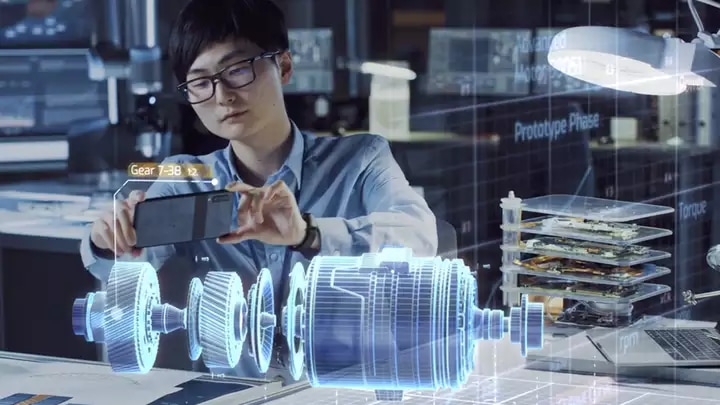NOKIA - The Metaverse Won’t Exist Without the Network. Our Next Decade Will Be Marked by Unparalleled Technological Progress Shaping Life as We Know It.

By 2030, the world will have undergone a significant transformation. The global rate of technology adoption will be impacted by trends such as environmental sustainability and cybersecurity. Advances in semiconductors, software, artificial intelligence (AI) and machine learning (ML) will continue to accelerate. But it will be the development of technologies that power the metaverse, cloud and Web3 that will have the potential to improve both the quality of our lives and our work. Technologies such as augmented reality (AR) will provide increasingly immersive and interactive virtual simulations in the physical world around us. Cloud computing will be central to a future internet that is both sustainable and secure. And blockchains, cryptocurrencies and non-fungible tokens (NFTs) will give power back to users in the form of ownership.
The metaverse will revolutionize our world
The consumer metaverse has drawn a lot of attention, but it is enterprises and industries that stand to benefit the most from metaverse technologies, far beyond the current realms of virtual reality (VR), gaming, and social interaction. Enterprise and industrial metaverses have the potential to significantly increase insights, productivity and safety.
To fully realize this potential, the network and a wide range of technologies that surround us will need to evolve dramatically. Next-generation networks must be developed and deployed to make high-performance connectivity more consumable, adaptable and autonomous. The next evolution in networking will see networks and cloud converge, opening new possibilities in the future immersive world. Human augmentation and digital-physical fusion are the two most significant driving forces behind future developments of the network. Five years of research by Nokia Bell Labs on these technologies has set the stage for a revolutionary new era in communications and metaverse enablement.
Human augmentation
The primary objectives of human augmentation are the improvement of human-computer interfaces and the creation of fully immersive experiences. Add-ons such as VR goggles, extended reality (XR) glasses, remote-controlled haptic feedback and brain-machine interfaces can allow users to interact in the metaverse.
Digital-physical fusion
Digital-physical fusion entails the creation and manipulation of dynamic representations of real-world objects, systems, and processes in the digital world. Digital twins of vehicles, warehouses, and production lines are already used by modern manufacturing and logistics facilities to increase output, lower costs and improve worker safety. By 2030, this technology will be widely used across businesses. Ubiquitous, next-generation networking will make this happen.
Opening new metaverse opportunities
There's no denying the vast potential that metaverse technology offers across the consumer, enterprise and industry sectors. This is why every major company is jumping into the metaverse now. We are already seeing the positive results of metaverse applications in industries where digital twins have been integrated into operations and are delivering significant uplifts in productivity, sustainability, and worker safety. The metaverse has the potential to revolutionize the ways in which organizations engage with customers, carry out operations, create and deliver goods and services, and manage business relationships.
Imagine a fully automated, lights-out, manufacturing facility that operates without human supervision. Connected digital twins monitor and analyze the performance and health of all critical resources and processes in real-time, allowing for automated decisions such as switching production between resources to increase productivity or avoid a predicted costly failure.


Why the network matters
The network is critical to realizing the enormous range of potential that the metaverse opens up in the industrial, enterprise and consumer spheres as we approach 2030. Nokia anticipates that the next decade will therefore usher in a period of profound change in network technology.
Built for unprecedented performance, the networks of the next decade will enable the massive capacity and scale needed to meet the growing demands of the metaverse. Metaverse services, such as fully immersive augmented and virtual reality, digital twins, and biosensors, have vastly different requirements for optimal connectivity. These requirements will eventually test the limits of even the most advanced 5G networks.
Our technology vision identifies nine areas where we believe network capabilities will need to evolve to fulfill the needs anticipated in 2030.
Industrial networks will often need to be highly optimized and tailored to meet the demands of specific industries. Consumer-centric metaverse services will need to be ubiquitously available, and metaverse services generally will demand significantly increased capacity from the network – both in a downlink and uplink direction. Networks can provide these services with optimal user experience if they are able to determine the user’s context by using advanced sensing and positioning technologies. And delivering services flexibly, leveraging the capabilities of distributed cloud architecture can provide the optimal balance between user experience and network resource utilization.
Across the board, the network will need to be designed to meet the most fundamental challenges of the world in 2030, with designed-in features focusing on sustainability and efficiency, security and privacy, and resilience and agility. Intent-based autonomy will enable networks to move towards becoming fully autonomous, using artificial intelligence (AI) and machine learning (ML) to intelligently orchestrate the network’s operations.
Multi-party value ecosystems will be essential to success
In the interconnected future, no business will be an island, and no single organization will be able to operate independently. The ecosystem players who will unlock the infinite new opportunities of 2030 will develop, integrate, use, and maintain new applications and devices that support the metaverse for consumers, enterprises, and industries. A rich, open, innovation-focused multi-party value ecosystem of developers, solution and service providers, and network operators will emerge to collaborate and realize value, fueled by emerging digital engagement tools and as-a-service business models.
The evolution to 6G
Wireless connectivity will be essential for many innovative and immersive use cases. Powerful new 5G-Advanced networks will emerge in 2025, and Nokia has laid a solid groundwork for them. These will pave the way for true XR experiences, which will eventually lead to the merging of the physical and digital worlds and the enhancement of humans. However, it won't be until the 6G era, around the year 2030, that the metaverse's true potential will be tapped.
Together, we’re creating the future
Nokia is bringing this vision to life, starting today. Our engineers are leading this evolution, creating networks that are dynamic enough to adapt to emerging applications, use cases and business models. Working together with our trusted ecosystem partners we will develop long-term answers to the world’s most pressing challenges and create a more sustainable, productive, and accessible future. By 2030, being able to connect to everything will be a big part of almost everything we do. Stay tuned for more thought-provoking ideas from our experts and valued ecosystems partners.

